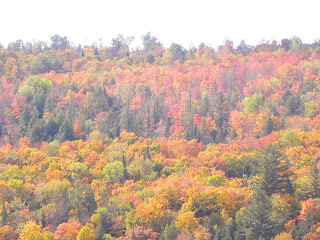
It is September, 2009, and it is time for us to take our annual pilgrimage to New England. About ten years ago, my wife inherited a summer home in West Falmouth, MA that had been her cousins. We rent it all summer as that is the only way we can afford to keep it, but when September comes we spend time there maintaining it and thoroughly enjoying our good fortune. At the same time, Peg's sister Christine has a summer home on the island of Cuttyhunk. Cuttyhunk is last in a series of Elizabeth Islands that go south from Woods Hole, MA. It is small island which attracts a lot of boaters in the summer, but has few year-long residents. The picture above shows the south west end of the island with some salt water ponds where oysters are farmed.
Leaving Cuttyhunk on the ferry to New Bedford, we pass near Penikese Island and see harbor seals gathering on nearby rock. Penikese has a long history as a biological station with Agassiz, a leper colony, and more recently a school for wayward boys.
Arriving back in West Falmouth, I have taken my bike and am riding down the newly created bicycle path that goes all the way to Woods Hole. Along the route is the Sippiwissett Marsh, a well studied salt water marsh along the shores of Buzzards Bay.
Here, along the bicycle path we can see a small colony of Great white egrets, enjoying the comforts of the day.
Back in West Falmouth, I look at the harbor from our porch and there sitting on the dock is a Great Blue Heron, trying to ignore the two laughing gulls sitting next to him/her.
Also present, are the many cormorants that ply the harbor water looking for fish. They are interesting birds, and like the anhinga of the southern states, they have to dry their wings after spending time in the water.
We take a drive over to Chapaquoit Island and I am attracted to a particular way in which an old anchor is draped over a post. I normally do not take pictures of inanimate objects, but this one caught my attention.
The next day we took a walk along the shores of Little Island, a wildlife preserve in West Falmouth. Again the cormorants are present everywhere.
In addition, there are reminders that big fish inhabit these waters. I find the remains of a striped bass along the shoreline. Coyotes, raccoons or skunks have have cleaned these bones quite well.
I can never seem to get enough pictures of great blue herons. I am fascinated by them and was luck enough to get this one as it just started to take off in flight. Such beautiful gracefull birds!
In the middle of Little Island, we noticed several great white egrets sitting in the trees.
And, the always present Limulus limulus, horseshoe crab shells that one finds very summer.
Arriving back at our summer home, I again look out into the harbor and notice an osprey atop the mast of a sailboat. At this time of the year, these osprey are the young of the year. Their parents have already gone south. It always amazes me to know that these young osprey somehow know where to fly south during their migration. It has to be genetic or somehow the information has been transferred from their parents.


On our way back home to Wisconsin, this year we have decided to go by the northern route through New Hampshire, Vermont and Canada. Our first stop is at my brother-in-law's home near Waterville Valley in New Hampshire. We are hoping to catch the fall colors.
While there we wander down to the Mad River and begin to observe the annual color change of the northern forest.
Something catches my eye. I lean down and take a close look. I see a small toad (or frog) and fortunately, a discarded bottle cap as a measure of size. I have yet to identify this amphibian.
Back at my brother in law's home, we begin to seethe real change of colors.
Absolutely magnificent!
We continue our journey home, now stopping at friends who have a summer cottage on Lake Willoughby in Vermont, not far from the Canadian border. It was almost dark when this picture was taken of the two mountains at the far end of the lake.
The next day, my friend takes us for a ride in his small power boat. We get closer to the end of the lake and begin to see the colors on the side of the mountain.
A closer view with a little more sun than the previous evening.
And finally, a picture worth a thousand words!































